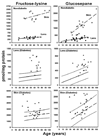Anaerobic vs aerobic pathways of carbonyl and oxidant stress in human lens and skin during aging and in diabetes: A comparative analysis
- PMID: 20541005
- PMCID: PMC2910832
- DOI: 10.1016/j.freeradbiomed.2010.06.003
Anaerobic vs aerobic pathways of carbonyl and oxidant stress in human lens and skin during aging and in diabetes: A comparative analysis
Abstract
The effects of anaerobic (lens) vs aerobic (skin) environment on carbonyl and oxidant stress are compared using de novo and existing data on advanced glycation and oxidation products in human crystallins and collagen. Almost all modifications increase with age. Methylglyoxal hydroimidazolones, carboxymethyllysine, and carboxyethyllysine are severalfold higher in lens than in skin and markedly increase upon incubation of lens crystallins with 5mM ascorbic acid. In contrast, fructose-lysine, glucosepane crosslinks, glyoxal hydroimidazolones, metal-catalyzed oxidation (allysine), and H(2)O(2)-dependent modifications (2-aminoapidic acid and methionine sulfoxide) are markedly elevated in skin, but relatively suppressed in the aging lens. In both tissues ornithine is the dominant modification, implicating arginine residues as the principal target of the Maillard reaction in vivo. Diabetes (here mostly type 2 studied) increases significantly fructose-lysine and glucosepane in both tissues (P<0.001) but has surprisingly little effect on the absolute level of most other advanced glycation end products. However, diabetes strengthens the Spearman correlation coefficients for age-related accumulation of hydrogen peroxide-mediated modifications in the lens. Overall, the data suggest that oxoaldehyde stress involving methylglyoxal from either glucose or ascorbate is predominant in the aging noncataractous lens, whereas aging skin collagen undergoes combined attack by nonoxidative glucose-mediated modifications, as well as those from metal-catalyzed oxidation and H(2)O(2).
Copyright 2010 Elsevier Inc. All rights reserved.
Figures







References
-
- Monnier VM, Mustata GT, Biemel KL, Reihl O, Lederer MO, Zhenyu D, Sell DR. Cross-linking of the extracellular matrix by the maillard reaction in aging and diabetes: an update on "a puzzle nearing resolution". Ann N Y Acad Sci. 2005;1043:533–544. - PubMed
-
- Lee KW, Mossine V, Ortwerth BJ. The relative ability of glucose and ascorbate to glycate and crosslink lens proteins in vitro. Exp Eye Res. 1998;67:95–104. - PubMed
-
- Saxena P, Saxena AK, Cui XL, Obrenovich M, Gudipaty K, Monnier VM. Transition metal-catalyzed oxidation of ascorbate in human cataract extracts: possible role of advanced glycation end products. Invest Ophthalmol Vis Sci. 2000;41:1473–1481. - PubMed
-
- Tarsio JF, Wigness B, Rhode TD, Rupp WM, Buchwald H, Furcht LT. Nonenzymatic glycation of fibronectin and alterations in the molecular association of cell matrix and basement membrane components in diabetes mellitus. Diabetes. 1985;34:477–484. - PubMed
-
- Sakata N, Meng J, Takebayashi S. Effects of advanced glycation end products on the proliferation and fibronectin production of smooth muscle cells. J Atheroscler Thromb. 2000;7:169–176. - PubMed
Publication types
MeSH terms
Substances
Grants and funding
LinkOut - more resources
Full Text Sources
Other Literature Sources
Medical

